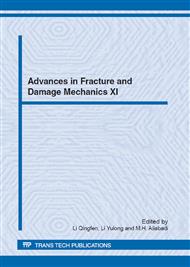p.501
p.505
p.509
p.513
p.517
p.521
p.525
p.529
p.533
Numerical Simulation of Crack Tip Behavior under Fatigue Loading
Abstract:
Fatigue damage is a localized phenomenon controlled by the near-tip crack behavior. This paper presents an application of a dislocation distribution technique to the simulation of crack tip behavior under fatigue loading. A centre-cracked tension specimen under uni-axial fatigue loading is used in the study. Crack opening and plastic deformation around the crack tip are simulated by distributions of dislocation dipoles in crack plane and four inclined planes ahead of the crack tip. Climb dislocation dipole is used to model the opening and closing of the crack while glide dislocation dipole is used to simulate the backward and forward slip in the inclined planes during loading and unloading of the fatigue cycle. Stress field around the crack tip is obtained by the superposition of the contributions of the applied external load and the distributed dislocation dipoles. Correct boundary conditions of the model are achieved by employing a quadratic programming technique to minimize a properly constructed non-negative object function. It is found that the simulated crack closure variations under the constant amplitude fatigue load agree well with the result of a previously developed modified strip yield model with an appropriate constraint factor.
Info:
Periodical:
Pages:
517-520
Citation:
Online since:
November 2012
Price:
Сopyright:
© 2013 Trans Tech Publications Ltd. All Rights Reserved
Share:
Citation:


